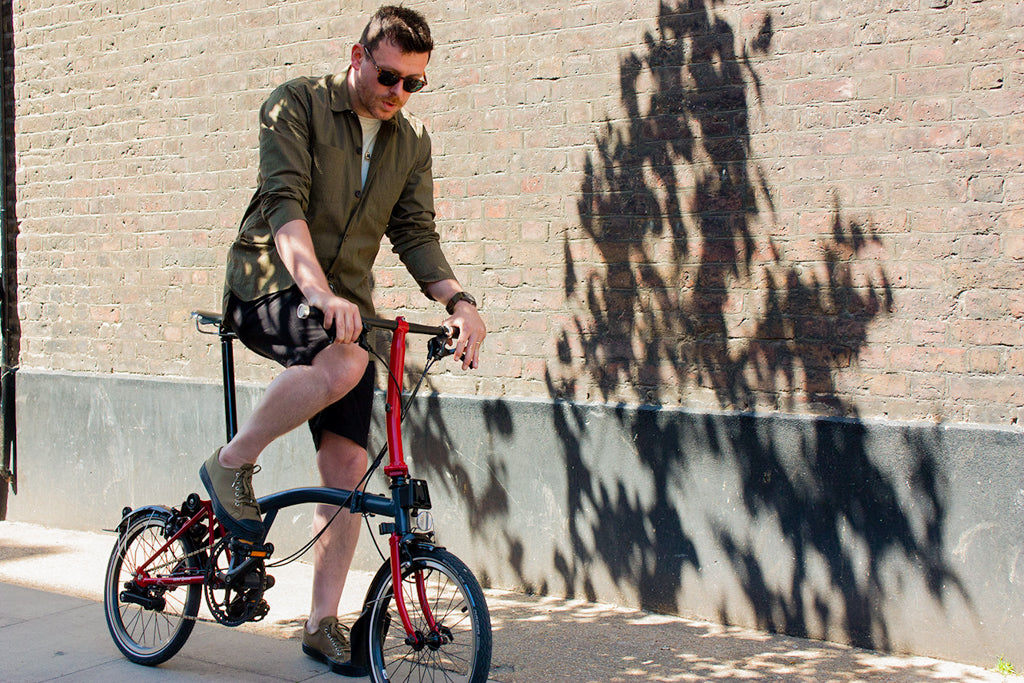As lockdown lifts, many of us will be facing something of a commuter conundrum: how exactly to get to work without stepping for on overcrowded public transport. The most obvious (and fun) solution is of course by bicycle. Now if you're a Lycra warrior that's all well and good. You guys have an abundance of excellent wind-tunnel wares to pull over your body. But what of the more casual commuter who just needs to get from A to be B without turning into a sweaty mess in the process? Not all offices have shower facilities, so keeping cool, both literally and figuratively, is important on your journey.

Our SS20 collection. comprises a multitude of lightweight breathable fabrics, such as organic cotton, seersucker and linen, together with some weather-proof technical fabrics, not least our limited edition Brompton blazer. Such garments avoid the need to shower down when you get to work (provided you're not doing your own Greater London version of the Paris-Roubaix every morning) since they are naturally breathable.
Seersucker lends itself perfectly to being on a bike since the dimpled fabric creates tiny pockets next to your skin that allows the free movement of cooling air. A courier bag is also essential for taxiing your belongings. Since it sits at the base of your back, you'll sweat far less than if you were wearing a backpack, while US Rubber Co.'s military low tops will give your feet all the assurance they need on the pedals.

Besides the countless fun you can have on your commute (bunnyhopping off curbs, taking shortcuts, definitely not running reds, and racing fellow commuters while pretending not to race them) cycling does of course have some serious sustainability upside. According to the European Cyclist Federation a bike produces 21g of carbon per km cycled. To break this down, 5g per km comes from the footprint of producing the bike and the remaining 16g per km comes from the food the rider eats to power the bike. If you travel a 15km return journey from work (5 days a week) this produces 1.5kg per week. Assuming you take 4 weeks off work a year, this has a footprint of 75kg per year.
How does that match with the combustion engine? On average a car produces 42g of carbon per km for production of the vehicle and 271g of carbon per km travelled for fuel. Based on the same calculations this produces 23.5kg of carbon per week and 1,127kg of carbon a year, which is more than four return flights between London & Rome. Stepping from car to bus immediately reduces your footprint by half, while a train is even better. Cycling is the clear environmental leader of travel, saving a maximum of 1052kg of carbon per year.

Then there’s the question of your lockdown-induced cuddliness. It’s safe to say that many of us haven’t been quite as active at home as we would have liked. Bless Joe Wicks, I’m sure he’s lovely, but those Ozark/Tiger King/Insert Binge Series episodes were not going to watch themselves. Based on our previous distance calculations, cycling can burn 446 calories a day. That’s 2,230 calories a week and 107,040 a year. Or in simpler terms: fit. Fit, apparently is the new rich, so you can think of cycling a bit like compounding, since it’ll save you in the pocket too. With all costs factored in, driving can cost around £20 a day, riding the bus will cost around £4.50 a day and getting the underground will cost around £5 a day. If you have an £800 bike (the price of Brompton) that lasts for 5 years, with £300 services costs over that period, then cycling costs 90p per working day. No brainer.
One thing we do understand is that people can feel nervous about their safety when cycling on the roads and this is a very valid concern. Safety comes first. But most major cities are now focusing on building safer cycle routes so please look into these to see if they can help. Just last week, Transport for London released a new cycle route map to help two-wheeled commuter better navigate the city. All in all, there are no excuses not to saddle up this summer.
